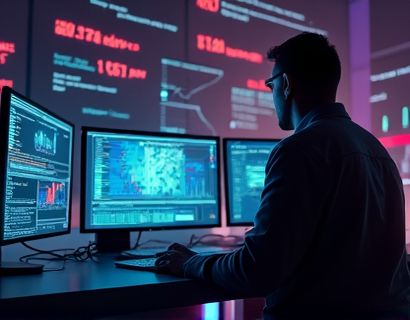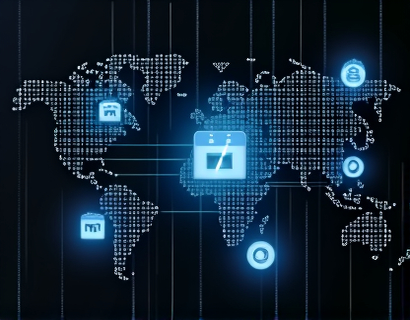Blockchain-Enabled Real-World Asset Tokenization: Unlocking Liquid Value and Market Accessibility
Blockchain technology is at the forefront of a transformative shift in asset management, offering a novel approach to the tokenization of real-world assets. This innovative method not only enhances liquidity but also broadens market accessibility, integrating physical assets into the digital realm with unprecedented security and transparency. The potential for individuals and businesses to unlock new opportunities is vast, as blockchain streamlines transactions and fortifies trust in the market.
The traditional asset management landscape is characterized by cumbersome processes, high transaction costs, and limited liquidity. Real-world assets, such as real estate, art, and infrastructure, are often illiquid due to their tangible nature and the complexities involved in transferring ownership. Blockchain technology addresses these challenges by providing a decentralized, immutable ledger that facilitates seamless and secure asset tokenization. This process involves converting the ownership rights of a physical asset into digital tokens, which can be traded on blockchain platforms.
One of the primary benefits of blockchain-enabled asset tokenization is the enhancement of liquidity. Traditional assets are typically held for long periods due to the difficulty in finding buyers or the high costs associated with transactions. Tokenization breaks down these barriers by allowing asset owners to sell fractions of their holdings, thus making investments more accessible to a wider range of investors. For instance, a real estate property can be divided into multiple tokens, each representing a small percentage of the property's value. This fractional ownership model attracts a broader investor base, increasing the asset's liquidity and potential for higher returns.
Moreover, blockchain technology ensures transparency and trust in asset transactions. Every transaction is recorded on a public ledger, which is immutable and accessible to all participants. This transparency reduces the risk of fraud and errors, as all parties can verify the authenticity and history of the asset. Smart contracts, self-executing contracts with the terms directly written into code, further automate and enforce the terms of asset transactions, reducing the need for intermediaries and lowering transaction costs.
The integration of real-world assets into the blockchain ecosystem also enhances market accessibility. Investors who previously could not afford to enter certain markets due to high entry barriers can now participate with minimal capital. For example, art collectors can invest in fractions of high-value artworks, and small investors can participate in real estate markets that were once exclusive to large institutional investors. This democratization of access not only diversifies the investor base but also injects more capital into the market, driving growth and innovation.
Another significant advantage of blockchain-enabled asset tokenization is the improved efficiency of asset management. Traditional asset management involves numerous intermediaries, such as brokers, lawyers, and banks, which add layers of complexity and cost. Blockchain technology streamlines these processes by enabling direct peer-to-peer transactions. Asset owners can directly interact with buyers, and smart contracts automate the execution of transactions, ensuring that all conditions are met before the transfer of ownership occurs. This reduces the time and cost associated with asset transfers and enhances the overall efficiency of the market.
Furthermore, the tokenization of real-world assets opens up new possibilities for asset-backed financing. Traditional lending models often require collateral in the form of cash or easily liquid assets, limiting the options for borrowers. Tokenized assets can serve as collateral on blockchain platforms, providing borrowers with more flexible and accessible financing options. For instance, a business owner can use tokens representing their equipment or inventory to secure a loan, with the tokens being repaid as the business generates revenue. This model not only increases the availability of credit but also reduces the risk for lenders, as the collateral is digitally secured and easily verifiable.
The environmental and social impact of blockchain-enabled asset tokenization should also be considered. By facilitating more efficient and transparent transactions, blockchain reduces the environmental footprint associated with traditional asset management processes. The reduction in paper usage, physical storage, and travel for transactions contributes to a more sustainable financial ecosystem. Additionally, tokenization can support social causes by enabling investments in projects that have a positive social impact, such as renewable energy initiatives or community development projects. The transparency of blockchain ensures that investors can track the impact of their investments, fostering a more responsible and ethical investment landscape.
Despite the numerous benefits, the tokenization of real-world assets is not without challenges. Regulatory frameworks are still evolving, and the lack of clear guidelines can create uncertainty for participants. Ensuring compliance with existing financial regulations while leveraging the advantages of blockchain technology requires careful navigation. Additionally, the technical complexity of blockchain and tokenization can be a barrier for some asset holders and investors. Education and user-friendly platforms are essential to overcome these hurdles and promote widespread adoption.
To address these challenges, industry stakeholders are actively collaborating to develop standardized frameworks and best practices. Regulatory bodies are beginning to recognize the potential of blockchain and are working towards creating a supportive environment for asset tokenization. For example, some jurisdictions have introduced sandboxes to allow innovators to test blockchain-based solutions in a controlled setting, paving the way for broader adoption. Educational initiatives and community-driven projects are also playing a crucial role in demystifying blockchain technology and making it more accessible to a wider audience.
Looking ahead, the future of blockchain-enabled real-world asset tokenization holds immense promise. As technology continues to advance, we can expect even more sophisticated applications and integrations. For instance, the combination of blockchain with the Internet of Things (IoT) can enable real-time monitoring and management of physical assets, further enhancing the efficiency and reliability of tokenized assets. Additionally, the rise of decentralized finance (DeFi) platforms is creating new opportunities for asset tokenization, offering decentralized lending, borrowing, and trading services that are transparent, secure, and accessible to all.
In conclusion, blockchain-enabled real-world asset tokenization is revolutionizing the asset management industry by unlocking liquid value and expanding market accessibility. By integrating physical assets into the digital ecosystem, this technology enhances liquidity, transparency, and efficiency, while reducing costs and barriers to entry. As the ecosystem matures and regulatory frameworks evolve, the potential for innovation and growth in this space is vast, offering exciting opportunities for investors, asset holders, and the broader financial community.










































